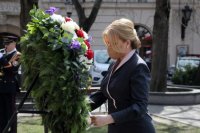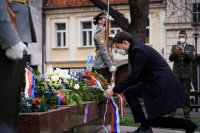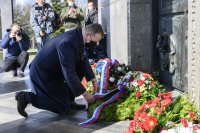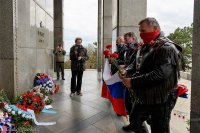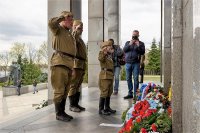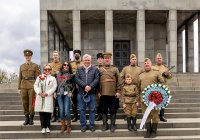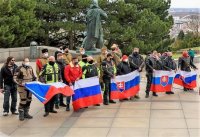
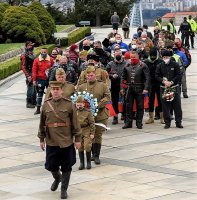 In that distant April 1945, the liberation of Bratislava fell on Easter week. The victory of the light Christian holiday over the dark forces of Nazism is symbolic.
In that distant April 1945, the liberation of Bratislava fell on Easter week. The victory of the light Christian holiday over the dark forces of Nazism is symbolic.
This year, despite the restrictions due to the pandemic, throughout the day on April 4, solemn actions and the laying of flowers were held in the city: at the Slavin memorial complex, at the Victory memorial on Eugen Sukhoni Square, at the monument to the sailors of the Soviet Danube flotilla on the Vayansky embankment, to the "Verba" plaque on Sturov Street; and to the memorial stone erected on the place of the former field cemetery of Soviet soldiers on Godzhevoi Square next to the Presidential Palace.
The events were attended by officials of the Slovak Republic - President Zuzana Chaputova, Prime Minister Eduard Heger, Mayor of Bratislava Matus Vallo, as well as Parliament Speaker Boris Kollar, who together with Russian Ambassador in Slovakia Igor Bratchikov, laid wreaths at the monument to the soldiers-liberators at the Slavin memorial.
Wreaths and flowers were laid by representatives of the embassies of Russia, Belarus and Kazakhstan, heads of the Russian Center of Science and Culture and the Union of Russians in Slovakia, the Russian Center in Bratislava of the European Foundation of Slavic Literature and Culture, the Slovak-Russian Friendship Society, members of the Military History Club from the city of Nitra and students of the Russian school from Bratislava, motorcyclists from different cities of the Czech Republic and Slovakia, compatriots, public figures and residents of the city of Bratislava.
April 1, 1945 was the main Catholic holiday of Easter. On this day, the soldiers of the 7th Guards Army approached the eastern outskirts of Bratislava, which the Nazis especially strongly fortified from the advancing infantry - barricades and reinforced concrete shelters, anti-tank ditches and minefields. However, on April 2, the corps of the 2nd Ukrainian Front under the leadership of Marshal of the Soviet Union Rodion Malinovsky, with the support of the Danube Flotilla, broke through the enemy's defenses. The sailors of the flotilla with an unexpected debarkation attacked the enemy's rear from the Danube.
Bratislava was released two days later. In the course of the continuation of the Bratislava-Brno offensive operation, the entire territory of Slovakia was completely liberated. Irrecoverable losses of the Red Army amounted to 17 thousand people.
The 23rd and 25th Guards Rifle Corps, the 252nd and 409th Rifle Corps, the 5th and 26th Anti-Aircraft Artillery Divisions received the honorary names "Bratislavian".
In honor of the courage and valor of the sailors of the Danube military flotilla in Bratislava, a monument was erected on the Danube embankment for eternal memory. Vice-Admiral Georgy Kholostyakov, 2nd Rank Captain Alexander Arzhavkin, Rear Admiral Alexei Matushkin, who were in charge of the operation, became honorary citizens of Bratislava.
In 2020, the Russian Ministry of Defense published a number of declassified documents from the military archive regarding the liberation of Bratislava from the Nazi invaders. The documents confirmed the crimes of the Nazis, showed how warmly the liberators were greeted, how, with the help of the Red Army, citizens quickly established water supply, launched power plants, and restored traffic on the roads.
Each visitor to the web-page http://bratislava75.mil.ru/ can independently familiarize himself with unique archival documents - combat reports from the fronts, cipher programs, political reports, award sheets and photographs.
